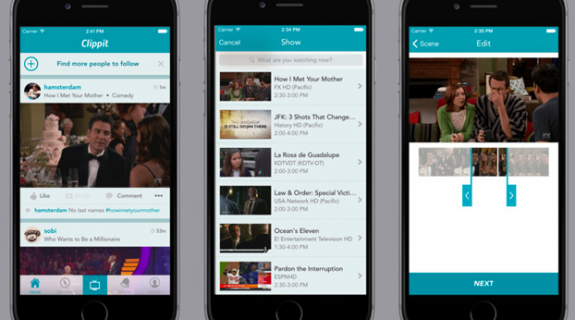The social TV conversation is going to be a lot more interesting in 2015, thanks to the rise of mobile apps that let users not just comment on big televised moments, but share the moments themselves.
One of the major players leading the charge in this space is Clippit, an application for iOS and Android that does pretty much exactly what its name suggests. Users simply press the TV set-shaped button within the app to call up a list of available on-air channels, select the show they wish to clip from and quickly trim their selection down to 30 seconds or less. The app constantly refreshes with the most recent footage from the current episode, breaking the video into manageable 1-minute chunks that are easy to whittle down. Then it’s just a matter of slapping on a witty caption and sharing it on Facebook or Twitter. The list of TV shows already available on Clippit is impressive, and growing all the time, and this writer was able to download the app, select a show (PBS Kids’ Dinosaur Train, naturally) and upload a clip in less than three minutes.
In addition to being fun, Clippit is a boon for TV marketers, said Jim Long, CEO of its parent company Didja. That’s because the effectiveness of broadcast media companies’ participation in their own social conversation is limited by at least a modicum of “preaching to the choir, posting stuff for the people already following them.”
While it’s certainly possible to amplify a message on social and “get beyond the choir,” Long said, speaking with Brief from Didja’s office in Silicon Valley, “you have to be careful… If I’m [already] a baseball fan and I’m getting posts from [Major League Baseball], I might be annoyed.”
Such is the conundrum of social media marketing in general – how to slip that message into those ever-scrolling feeds in a way that makes the post stand out without pestering. It’s especially tricky when it comes to disseminating video, which takes up far more space than text-based posts, can slow devices or computers down, and generally muck things up in ways that can breed resentment.
As with any form of marketing, it’s best to let the users do the video sharing over Facebook, Twitter and beyond. When you receive a video over social from a friend, you’re “not going to be annoyed,” said Long, and you’ll be “much more likely to click on it” than if it came from, say, MLB. “That relationship between friends is much more genuine than a media company could get on their own. [Cippit] allows existing fans to expose content to other fans… this is not something that’s easy for TV shows to do.”
Of course, people have been sharing video over the Internet for decades, whether in bite-sized chunks or complete wholes, by way of gifs or torrents or other methods, some of them legal and some of them not. Either way, said Long, it’s a problem for media companies because that content “doesn’t look good and it doesn’t necessarily say, ‘this is a new show on, [for example], TBS.’
The clips generated by Clippit are high-definition and look stunning, especially considering how quickly they can be created. And, each one has proper attribution for its given show. What’s more, said Long, there’s nothing illegal about it.
“These are your users doing it,” he said, taking the point of view of a media company who might be concerned about sharing something digitally they don’t have the rights to. “You’re not doing it… If you’re NBC or whatever you’re not doing the clips, your users are… It’s an open, simple area from a legal perspective.”
Ultimately, Clippit “is just an extension of the user,” said Long. “We’re a tool like your iPhone or your Facebook app,” and one that simply facilitates what is already happening in spades on services like Vine, where users do the same thing by recording their TV screens with their devices, resulting in much lower quality and no attribution.
Clippit, continued Long, lets media companies control their own narrative in the social clipping space, a realm where “users could do bad things if this kind of service went underground.” But, he said, to coin a recent example within another media industry, “if you [had built] iTunes before Napster happened, you [would have taken] all the incentive out of users doing that. Media companies helping users with clipping services [avoid getting] ‘Napsterized.’”
But aside from the element of self-protection, embracing services like Clippit could have big ramifications for TV business. Media companies can encourage user-generated content around their shows, by embedding Clippit’s technology into their own websites and social products. And, they can bring advertisers into the fold, pre- and post-rolling clips with commercials or conceivably letting sponsors send clips of their own. And of course, if sharing Tweets and Facebook posts drives tune-in, as it has been proven to do, sharing tweets and posts with the actual show clip under discussion conveniently attached can only drive more tune-in.
“We think when you get the crowd working for you, whether they’re sports fans or reality fans or recipe fans, [your viewers] are really your best sources of content ,” said Long. “This is a really good thing, particularly for live TV.”
Tags:












































__twocolumncontent.jpg)











